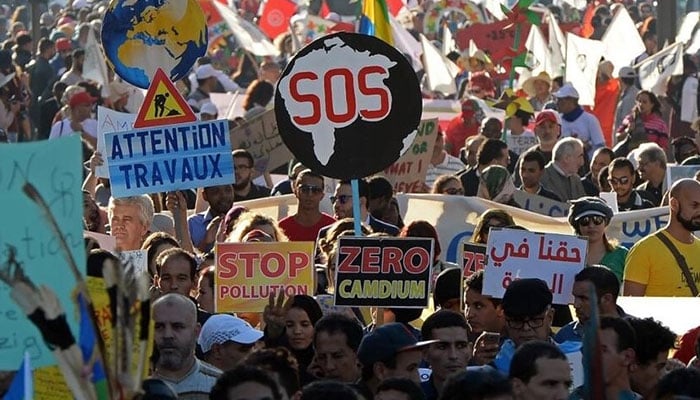Global climate chaos
Recent studies indicate that stratosphere is shrinking due to increased greenhouse gas emissions
July 23, 2024

Extreme weather events continue to manifest worldwide in various forms. A few days back, Toronto (Canada) experienced over 100 millimetres (about four inches) of rain, matching the average rainfall for all of July.
The thunderstorms led to torrential rain and flash flooding, leaving residents stranded, roads submerged, and nearly 170,000 customers without power. Toronto's Pearson Airport reported 97.4mm of rain within 3.5 hours. Prime Minister Trudeau called this a “significant event”, emphasising the need to intensify Canada’s fight against climate change.
In Pakistan, extreme heat has made life unbearable since June — with unusually hot and humid days having been observed recently.
Temperatures soared above 50°C across the country. In Karachi, a new phenomenon was seen where clouds appeared to touch tall buildings like Icon Tower and Dolmen Mall.
This could be due to a combination of meteorological factors, possibly fog enveloping skyscrapers, creating the illusion of clouds ‘touching’ the buildings. However, recent air turbulence incidents causing death and injuries to passengers suggest other climate change phenomena might be at play.
This year, several intense air turbulence incidents occurred, causing death and injuries. The most tragic was on May 21 when a Singapore Airlines flight from London to Singapore encountered severe turbulence, resulting in the death of a 73-year-old passenger and injuring 30 others.
The plane experienced a sudden drop of 177 feet in five seconds, causing passengers to be thrown against the cabin ceiling, leading to significant internal damage to the aircraft.
Another incident, on May 26, involved a Qatar Airways flight from Doha to Dublin encountering severe turbulence over Turkey, injuring twelve people – six passengers and six crew members. Upon safely landing at Dublin Airport, eight of the injured were taken to the hospital.
On July 9, a Saudi Arabian Airlines flight from Riyadh to Cairo experienced severe turbulence, injuring both passengers and crew. Reports indicated that the unexpected turbulence caused passengers to be thrown from their seats, even those wearing seat belts.
On April 17, an Air New Zealand flight from Bali to Auckland encountered severe turbulence shortly after takeoff. This clear air turbulence caused the aircraft to drop unexpectedly, leading to a passenger breaking his leg while returning from the lavatory.
Airplanes typically travel through the troposphere, the lowest layer of Earth's atmosphere, extending from the Earth's surface up to about 8 to 15 kilometres high. Most commercial flights cruise at altitudes within the upper troposphere, around 10 to 12km. There are speculations that extreme turbulence is due to the shrinkage of the troposphere caused by greenhouse gases. This shrinkage is mainly due to increased greenhouse gas emissions, which have two key effects: warming of the troposphere, causing it to expand and compress the stratosphere, and the addition of CO2 into the stratosphere, cooling and contracting its gases.
The stratosphere is the second layer of Earth's atmosphere, situated above the troposphere and below the mesosphere. It extends from about 10 to 15 kilometres above the Earth's surface to approximately 50 kilometres high. This layer contains the ozone layer, which is crucial in protecting life on Earth by absorbing most of the sun's harmful UV radiation.
Recent studies indicate that the stratosphere is shrinking due to increased greenhouse gas emissions. This shrinkage has profound implications for air travel safety and weather patterns. With the troposphere expanding and compressing the stratosphere, the atmosphere's stability is compromised, potentially leading to more frequent and severe turbulence. This turbulence poses significant risks to aviation, as demonstrated by the numerous incidents reported this year.
In addition to turbulence, lightning activity has increased as a result of global warming. Studies suggest that for every degree Celsius rise in global temperature, lightning strikes could increase by approximately 12%. Some projections estimate that the frequency of lightning strikes could surge by about 50% by the end of the century if current warming trends continue.
Warmer temperatures contribute to more intense thunderstorms, producing more lightning. This escalation in lightning activity not only endangers lives but also exacerbates the risk of wildfires, further contributing to the cycle of climate change.
The tragic deaths during Hajj this year due to extreme heat, unusual rains in New Delhi, Dhaka, China, Dubai, Oman and now Toronto, alongside extreme air turbulence, suggest that the ugly face of climate change has taken the world off guard, posing a potential all-out war against civilisation.
The writer is an expert on climate change and sustainable development and the founder of the CliftonUrban Forest. He posts@masoodlohar and can be reached at:[email protected]
Disclaimer: The viewpoints expressed in this piece are the writer's own and don't necessarily reflect Geo.tv's editorial policy.
Originally published in The News









